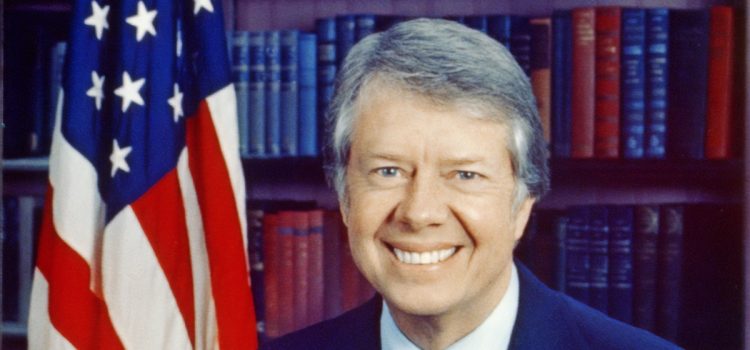

This article is an excerpt from the Shortform book guide to "His Very Best" by Jonathan Alter. Shortform has the world's best summaries and analyses of books you should be reading.
Like this article? Sign up for a free trial here.
How did Jimmy Carter reshape the role of the vice president? Why was the Department of Energy created? What are the highs and lows of Carter’s foreign policy?
Supporters of Jimmy Carter would probably rather talk about his post-presidential years than his time in the White House. However, biographer Jonathan Alter thinks the Carter Administration deserves another look. While mistakes were made, Alter believes Carter’s achievements should be acknowledged.
Continue reading for Alter’s assessment of Jimmy Carter’s presidency.
The Carter Administration
Jimmy Carter isn’t remembered as a great president, but he’s come to be revered for his work as a humanitarian. However, in His Very Best, Jonathan Alter presents a fresh perspective on the groundbreaking work of the Carter Administration. Instead of focusing on the hardships America suffered during Carter’s time in office, Alter draws attention to the long-term effects of what Carter accomplished while president. Alter paints Carter as deeply principled yet politically short-sighted in a way that let him achieve great things while undermining his legacy.
Carter the Reformer
Carter had campaigned on a promise to correct the course of government, and as soon as he entered office he put that promise into action. Though many of his choices proved unpopular in the short term, Alter contends that Carter enacted many governmental improvements that remain undervalued in the common narrative of his presidency. The lasting changes Carter implemented involved reshaping the administration of the executive branch, taking steps to address US energy policy, and bringing diversity to the judiciary.
(Shortform note: The US government is divided into three co-equal branches—the legislative branch (Congress) that writes and passes laws, the executive branch (headed by the President) responsible for enacting laws and government policy, and the judicial branch (headed by the Supreme Court) which interprets the law and on occasion overturns it. US Presidents such as Carter cannot create laws on their own, but they have the power to approve or veto laws passed by Congress as well as to appoint judges and other government positions.)
The most dramatic alterations Carter made to the executive branch were to redefine the roles of the Vice President (VP) and First Lady. Carter positioned VP Walter Mondale as a full partner, including him in all presidential briefings and placing him second in the military chain of command. Carter also included Rosalynn in all briefings and cabinet meetings—except those for which she didn’t have a security clearance—and regularly consulted her before making important decisions of state. Finally, he overturned convention by empowering his cabinet members over White House staff, whom he treated in much the same demanding way that his father and Admiral Rickover had treated him—expecting excellence without praise.
(Shortform note: By elevating the role of the Vice President, Carter set a template that others would follow, most notably George W. Bush, under whom VP Dick Cheney did much to reshape tax law, US energy policy, and national security. Likewise, while there were First Ladies who engaged with policy issues before Rosalynn Carter—for example, Eleanor Roosevelt—it has now become expected that the President’s spouse will use their platform to advocate on behalf of various causes. While Rosalynn Carter was sometimes criticized for her political activism, she replied that the role of First Lady should grow to reflect the changing role of women in society.)
The US that Carter inherited was in the midst of steep inflation and gas shortages brought about in part by a reliance on foreign oil. Carter spent his first 100 days in office shaping his National Energy Plan, which he didn’t sugarcoat for the public when he described the energy crisis as an existential threat to the country. The legislation that Carter passed through Congress produced short-term hardships in the form of higher energy costs while curbing inflation in the long run. Carter’s plan also resulted in the creation of the Department of Energy, which would oversee future energy research and conservation efforts.
(Shortform note: The energy crisis that impacted Carter’s term began after US oil production peaked in 1971 and declined as demand for fuel rose, resulting in a dependence on oil from the Middle East. In response to President Nixon’s support for Israel in the 1973 Yom Kippur War, the Arab nations slowed down oil production and decreed an embargo on exports to the US. Even though the embargo ended quickly, the combination of rising energy costs and rampant inflation compounded to keep oil prices high, a situation made worse by a second drop in imports midway through Carter’s term due to the Iranian crisis, which we’ll discuss later.)
A bill passed in 1978 added 152 judicial positions, which Carter used as an opportunity to bring diversity to the court system. He convinced the Senate Judiciary Committee to create an independent commission for nominations, which he then directed to specifically look for minority candidates. In total, Carter appointed more judges than any other president, and his appointees included African-Americans, Hispanics, and women—most notably Ruth Bader Ginsburg, who would later serve on the Supreme Court. Alter suggests that if Carter had had the opportunity to appoint a Supreme Court justice, he would have nominated the first woman to serve. Despite that, Carter successfully reshaped the judiciary in favor of diversity and equality.
(Shortform note: As an example of the lack of diversity within the legal system of the time, Ruth Bader Ginsburg had a hard time finding work even as a law clerk, despite graduating at the top of her class from Columbia Law School in 1959. In the ’70s, she argued several sex discrimination cases before the Supreme Court, though her clients were usually men—such as widowers who were denied their wives’ death benefits or a convicted felon whose all-male jury wasn’t representative of his community.)
Carter the Diplomat
On the global stage, Carter distinguished himself as a president who would eschew the use of military strength except as a last resort. Instead, he prioritized maintaining and promoting peace at any cost, including political damage to himself. While Carter’s presidency included dramatic successes such as averting a military crisis in the Panama Canal and negotiating a lasting peace between Israel and Egypt, his legacy was ultimately marred by his response to the Iranian Revolution and the subsequent hostage crisis, which we’ll discuss in a later section.
Alter writes that Carter was determined to do the right thing regardless of the political consequences. A prime example of this was giving Panama control of the Panama Canal, which by treaty belonged to the US forever. Perpetual American control of the canal bred anti-US resentment in Panama and neighboring countries that threatened to erupt into violence. Had it done so, the US would have been forced to defend the canal and all the traffic through it in a conflict that might have eclipsed the Vietnam War in scope and duration. Presidents Johnson, Nixon, and Ford had all broached the topic of transferring ownership of the canal to Panama, but it had been blocked by fierce congressional opposition.
Carter’s fellow politicians considered any attempt to give away the canal to be tantamount to political suicide, but Alter says that Carter viewed indefinite US control to be morally unjust to the Panamanian people. Carter hashed out a new deal with Panama, and to get it ratified by the Senate, he framed it as two separate treaties—one ensuring that the canal would remain open and neutral, and another handing over control of the canal to Panama in 1999. The neutrality treaty passed by one vote, and Carter spent a lot of political capital to make sure the handover treaty passed as well. Though giving away the canal proved unpopular in the US, it protected a vital global trade route and kept the US out of another costly war.
The Camp David Accords
Another conflict where Carter felt compelled to intervene was that between Israel and its Arab neighbors. Though open fighting halted in 1973, Egypt and Israel were still technically at war, and thousands of Palestinians lived in refugee camps. Carter valued Israel because of his religious convictions, but Alter says Carter sympathized with the Palestinians, whom he felt were enduring the same conditions that his Black neighbors had during segregation. He reached out to Middle Eastern leaders in the hopes of brokering a lasting peace and connected strongly with Egyptian President Anwar Sadat. Carter hosted talks between Sadat and Israel’s prime minister Menachem Begin at Camp David, the presidential retreat outside Washington.
Over two weeks of intense negotiations, Carter mediated between the two leaders, doing everything he could to produce an agreement. Alter explains that, just as with Panama, Carter arrived at a two-treaty solution—one to ensure Israel’s withdrawal from Egypt’s Sinai Peninsula and one to restrict Israel’s presence in the West Bank while talks continued toward Palestinian independence. While the latter never came to fruition, the peace between Egypt and Israel has held since the Camp David Accords were accepted.
The Iran Hostage Crisis
While Carter was achieving a measure of success negotiating peace between Israel and Egypt, the political situation in Iran was deteriorating faster than anyone in the US realized. The Iranian Revolution and the 444-day hostage crisis that followed would become for many people the defining historical event of Carter’s presidency, completely dominating his last year in office. Alter details the road to the crisis, Carter’s resistance to using military force, and the final push to free the hostages just as Carter’s presidency came to its end.
In Iran, Ayatollah Khomeini gained a following as a fierce critic of Mohammad Reza Shah, Iran’s dictator since 1953, but the CIA never saw Khomeini as a serious threat to world peace. In 1978, the Shah’s health began failing, and Khomeini’s supporters launched violent protests to demand the Shah’s removal. Alter writes that when the Shah asked the US for aid to prop up his regime, Carter refused, believing that without a dictator, Iran would return to democratic rule. Suffering from cancer, the Shah went into exile in January 1979 to seek medical treatment abroad while Khomeini amassed power in his country.
Alter argues that there was nothing Carter could have done to prevent the Shah’s downfall or Khomeini’s rise to power, but he notes that Carter was taken aback by the strength of anti-US sentiment in Iran. So, as not to stoke that anger—and to protect US citizens still in Iran—Carter repeatedly denied the Shah entry into the US until October 1979, when he was told that the Shah would die without treatment at an American hospital. Giving in to his humanitarian values, Carter granted the Shah temporary medical asylum. The Iranian response was stronger than anyone expected.
The Hostages Are Taken
Islamist groups within Iran believed the Shah’s presence in the US was part of a scheme to return the Shah to power. On November 4, 1979, under Khomeini’s direct approval, Iranian students stormed the US embassy in Tehran looking for evidence of a plot against Iran, taking the staff as prisoners in what was meant to be a short occupation. A rescue was unfeasible since Tehran was so far from US military forces. More than that, Carter feared that any attack would result in hostage deaths while dragging the US into another war. Carter placed sanctions on Iranian oil, froze Iranian bank accounts within the US, and made one attempt at a military rescue that failed because of the US military’s inability to coordinate between branches.
Within Iran, Khomeini used his control of the crisis to establish himself as the head of a constitutional theocracy while not allowing hostage negotiations to take place unless the Shah was returned to stand trial for alleged crimes against the Iranian people. Once it was clear that Carter wasn’t going to retaliate, Khomeini knew he could hold the hostages indefinitely. At home, the hostage crisis brought the American people together while painting Carter as an ineffective leader. Alter states that this was also the US public’s first introduction to radical Islam.
The Hostage Crisis Ends
Carter devoted nearly all his focus to resolving the hostage situation, attempting to negotiate through other countries as intermediaries instead of campaigning hard for reelection. Even the Shah’s death in June 1980 didn’t bring about the hostages’ release. Instead, Alter suggests that two other factors caused Khomeini to finally relent. One was Iraq’s invasion of Iran under the command of Saddam Hussein—suddenly, Iran needed access to the funds that were frozen in US bank accounts. The second factor was a fear that Carter’s electoral opponent, Ronald Reagan, wouldn’t share Carter’s hesitation to use military force if he won the election.
Thanks to Carter’s divided attention, the state of the economy, and the crisis in Iran, Reagan won a landslide victory. Nevertheless, Carter’s work wasn’t finished. In the final days of his presidency, Carter, at last, brokered a deal for the hostages’ freedom, though Khomeini delayed their release until Reagan took the oath of office. President Reagan announced the end of the crisis while Carter and Mondale flew to Germany to greet the freed captives in person. Although the public had turned against Carter, Alter reiterates that the president had kept the US out of war throughout all four years of his term, a feat unmatched by any following president.

———End of Preview———
Like what you just read? Read the rest of the world's best book summary and analysis of Jonathan Alter's "His Very Best" at Shortform.
Here's what you'll find in our full His Very Best summary:
- A fresh perspective on Jimmy Carter's time as president
- How Carter's early life shaped his political career
- The long-term effects of what Carter accomplished while president






